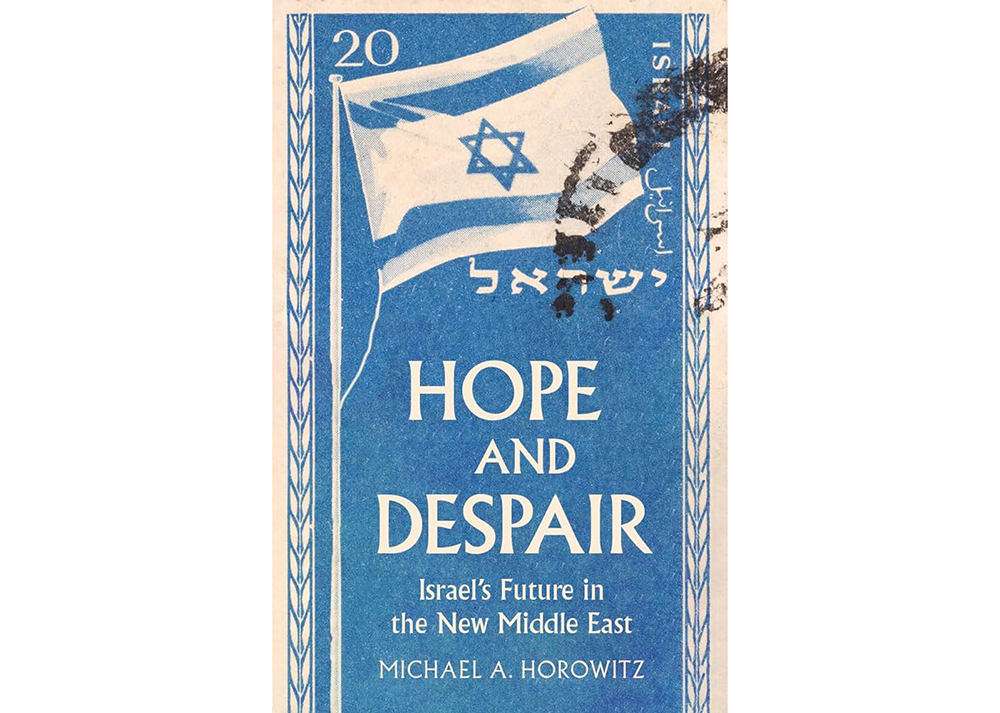|
Getting your Trinity Audio player ready...
|
REVIEW: ‘Hope and Despair: Israel’s Future in the New Middle East’ by Michael Horowitz
By: Sean Durns
Israel is in peril. The Islamic Republic of Iran and its proxies have sworn to destroy the Jewish state, and the horrors of October 7 prove that Tehran intends to make good on its promises. Yet Israel also enjoys improved relations with many of its Arab neighbors, notably in the Gulf. In his new book, Hope and Despair: Israel’s Future in the New Middle East, Michael Horowitz explores this dichotomy.
An analyst of Middle Eastern affairs and a former soldier in the Israel Defense Forces, Horowitz examines recent events with an eye toward ensuing decades. The book, he writes, is “not meant to be a rhetorical debate, a dissertation, or an academic essay. Each of these formats has failed us, Israelis and Palestinians, in many ways.” Rather, he hopes that it is “an examination” of the “tension between tremendous hope and deep despair and an attempt to see what future challenges may lie ahead for Israel, both in terms of security and beyond.”
Horowitz’s central thesis—that Israel confronts both grave challenges and tremendous opportunities—seems inarguable. Less than eight decades since its rebirth, the Jewish state has survived innumerable wars and countless challenges. Today, Israel is the famed “Start Up Nation,” a tech powerhouse whose skills and dynamism attract much fanfare. Indeed, in many respects the country is thriving, far removed, economically and otherwise, from the tired socialism of its founders.
When Israel was re-created in 1948, it was attacked by no fewer than seven Arab armies, all of whom rejected a United Nations partition plan that would’ve created two states out of the British-ruled Mandate for Palestine, one Jewish and the other Arab. Israel survived but lost almost 1 percent of its population in bloody combat.
For decades, Israel was in a state of near-constant war, often outnumbered by the combined weight and military muscle of the Arab states that vowed to destroy it. Yet the nation survived, outlasting many of the regimes, from Gamal Abdel Nasser’s Egypt to Saddam Hussein’s Iraq, that sought its destruction. And today Israel thrives, with a vibrant population, resilient people, and a cutting-edge economy.
But darkness looms. Iran, the world’s leading state sponsor of terrorism, has surrounded Israel with its proxy armies: Hezbollah in Lebanon, the Houthis in Yemen and the Red Sea, Hamas, Islamic Jihad, and others in Gaza, and a veritable rogues’ gallery of terrorists in Iraq, Syria, and the West Bank. Tehran seeks to engulf Israel in a “ring of fire” and is actively seeking nuclear weapons to perpetrate another Holocaust.
Iran is a formidable foe, excelling at asymmetrical warfare and profiting off the chaos it sows. The Islamic Republic seeks not only Israel’s destruction, but to supplant the United States as the preeminent power in the region. “This is a ‘New Middle East’ in which Israel has to find its footing,” Horowitz observes, “being presented with opportunities and risks that match the unprecedented nature of the change and the scope of transformation.”
Among the greatest transformations has been the Abraham Accords, in which leading Arab states, including Bahrain and the United Arab Emirates, among others, recognized Israel. The accords were, and are, a significant achievement by the Trump administration. In certain respects, including at the cultural and economic level, they exceed previous peace deals between Israel and the nations of Egypt and Jordan.
The accords were achieved thanks in large part to the Trump administration’s willingness to break with failed precedents, including the decision to discard the idea of “linkage”—the belief that peace with Arab states can only come after peace with Palestinians. More broadly, the accords reflect an important reality: Both Israel and leading Arab states have a shared enemy in Tehran. Iran seeks to overthrow monarchies in the Gulf that, in turn, correctly view Israel as the best counterweight to the mullah’s ambitions.
The accords, Horowitz observes, “brought something that felt completely new to the Israeli scene … hope. Hope that perhaps, for once, the region was changing for the better. … It suddenly broke the image of Israel as a fortress surrounded by enemies, walls, and Iron Domes.”
Hope and Despair does an excellent job of highlighting recent changes in both Israel and the Middle East. Horowitz deserves credit for detailing both Israeli and Palestinian political developments. He shows the former to be more complicated than many mainstream media narratives would have you believe. For example, his look at the various religious political parties in Israel, and their frequent role as kingmakers and moderators, is valuable. Ditto for his examination of Palestinian politics.
Horowitz correctly depicts Mahmoud Abbas, the octogenarian autocrat who heads the Palestinian Authority, as both corrupt and embattled. Abbas is currently in the 19th year of a single four-year term. He is deeply unpopular and has no clear successor in place. When he exits, chaos is sure to follow. This scenario is seldom discussed by leading news outlets. Horowitz performs a service by offering a detailed discussion of who might succeed him. The PA, he observes, is brittle, its institutions corroded by one-man rule. Indeed, the Palestinian Authority could very well go when Abbas does—a situation that would present both Israel and the United States with serious problems, and Iran and its proxies with opportunities.
Yet Hope and Despair does omit important context and details. The book argues that Israel is too disinterested in peace talks with Palestinians. Many Israeli leaders, Horowitz asserts, prefer the status quo instead of working toward a “two-state solution.”
But the author fails to detail the numerous occasions in which Palestinian leaders have rejected statehood if it meant living in peace next to a Jewish state. To wit, Palestinian leaders refused U.S. and Israeli proposals for statehood in 2000 at Camp David, 2001 at Taba, and 2008 after the Annapolis Conference, among other recent instances. If Israelis and many Arab leaders feel that the conflict is “unsolvable” as Horowitz says, this history helps explain why.
Horowitz’s assertion, moreover, that “Abbas has never supported calls for violence” against Israelis is false. Under Abbas, the PA has praised numerous terrorist attacks, including the October 7 massacre. The authority continues to pay tax-deductible salaries to those who murder and maim Jews, and its media and educational arms continue to encourage anti-Jewish violence. Abbas himself has incited violence, perhaps most notably in a 2015 speech during the so-called Stabbing Intifada, in which he said, “we welcome every drop of blood spilled in Jerusalem.” To make peace, one must first have a peace partner.
Horowitz also overlooks the role the Biden administration’s feting of Iran played in increasing regional tensions. He notes that progress on the Abraham Accords has slowed since 2021, but doesn’t connect this, or the dramatic reduction in American deterrence in the region, to the Biden administration’s decision to return to Obama-era policies centered around appeasing Tehran.
Despite these omissions, Hope and Despair is a serious and informative book, written dispassionately and anchored in serious analysis. “The region is changing in a way that Israel cannot control,” Horowitz warns. In the Middle East, it might be said, the more things change the more they stay the same.
Hope and Despair: Israel’s Future in the New Middle East
by Michael A. Horowitz
Hurst, 312 pp., $37.50
Sean Durns is a senior research analyst for the Committee for Accuracy in Middle East Reporting and Analysis.




